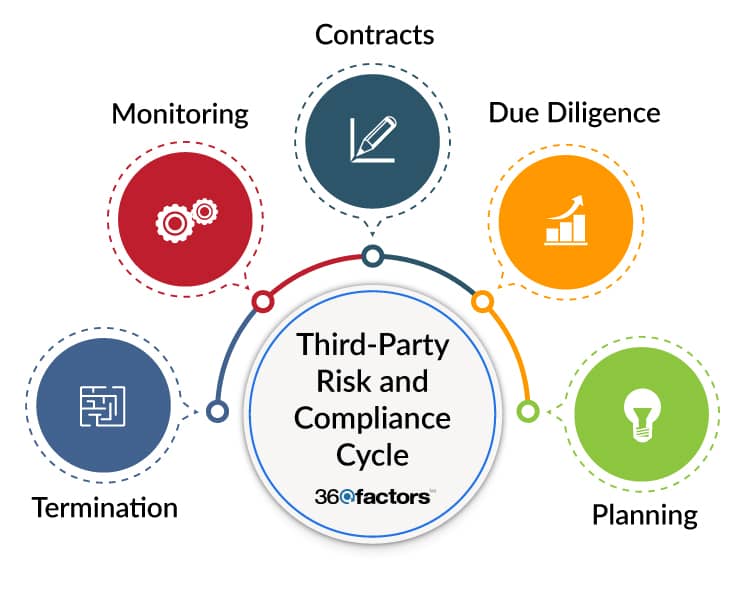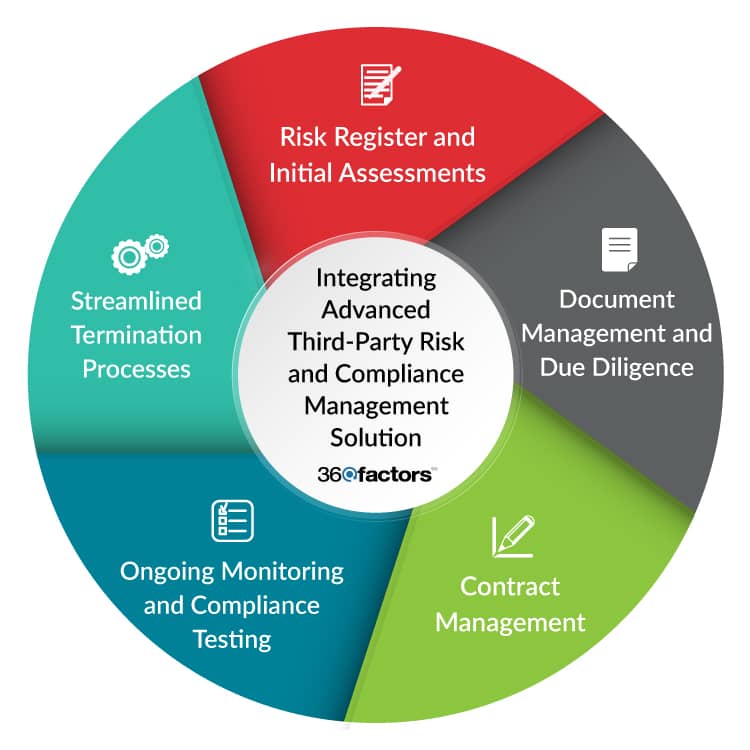Improved Third-Party Risk Management (TPRM) can have very positive effects on a business, as emphasized by the takeaways of the 2023 Global Third-Party Risk Management Study. 9 in 10 participants revealed that their companies invested directly in their third-party risk management program. These people also reported a better understanding of risk and enhanced expertise and significance.
A Third-Party Risk Management Program (TPRM) offers a structured method to decrease risks related to third parties, like suppliers, vendors, and contractors. It involves an evaluation procedure that recognizes, assesses, and remediates any risks influencing your business. Successful third-party risk management evaluations can protect companies against possible third-party risks and enhance seamless and confident partnerships with external collaborators.
Focusing on improved third-party risk management enhances relationships with any external business partners that an organization coordinates with. These include suppliers, vendors, consultants, service providers, partners, and collaborators who provide business services.
In the current era where interrelation and digital partnerships are not just trends but requirements, 3rd party risk management has emerged as a foundation of organizational strategic foresight and resilience. The recent global survey, as described in the widespread report by Ernst & Young (EY), sheds light on the evolving landscape of TPRM, highlighting its growing importance in today’s fast-paced and complexly connected financial industry.
As we explore the insights from this survey, it becomes evident that improved third-party risk management is not merely a compliance requirement but a strategic imperative. With the increasing reliance on third parties for critical services and operations, organizations are rapidly recognizing the need to fortify their defenses against potential risks from these external associations.
This blog will explore the key factors making the financial industry more focused on TPRM. We will delve into the intricacies of managing third-party risk and compliance effectively, examining the management cycle. As we embark on this journey, it’s crucial to remember that improved third-party risk management is not just a phrase to be repeated; it’s a mantra for organizational sustainability and success in the modern world.
Key Factors Reveal the Financial Industry Is More Focused on Improved Third-Party Risk Management (TPRM)
In the rapidly evolving landscape of the financial industry, the focus on Improved Third-Party Risk Management (TPRM) has become more pronounced than ever. Insights from the EY Global Third-Party Risk Management Survey shed light on this shift, emphasizing the strategic importance of third-party risk management frameworks in today’s interconnected business environment.
The survey underscores a significant trend: organizations increasingly prioritize improved third-party risk management. This shift is driven by the growing complexity of third-party networks and heightened regulatory scrutiny. In the financial sector, where the stakes are exceptionally high, this focus is not just about compliance but also about gaining a competitive edge. Effective TPRM leads to better decision-making and improved performance, making it a strategic function rather than a mere regulatory obligation.
Challenges in Effective TPRM Implementation
Despite the growing emphasis, many organizations need help managing third-party risks effectively. The survey reveals that a lack of a centralized TPRM function, inadequate technology support, and insufficient organizational skills in the enterprise are significant hurdles. In industries where improved third-party risk management relationships are intricate and complex, these challenges can significantly impede the effectiveness of risk management strategies.
Fortunately, financial organizations are a step ahead in TPRM management. The survey shows that 27% of financial services corporations have a multiyear TPRM plan with defined milestones and goals vs 21% of nonfinancial services. Economic sectors have more stable third-party risk management programs than other industries. One of the main reasons for this is that financial enterprises, including capital markets, banking, wealth management, and insurance, are far more regulated worldwide.
Financial service providers favor a centralized approach to improved third-party risk management (TPRM), with 62% adopting this structure, compared to 46% in non-financial sectors and 54% overall. While a clear roadmap is lacking in most companies, suggesting room for improvement, 27% of those in financial services have established a multi-year plan with specific milestones and objectives.
This is more prevalent than in non-financial sectors, where only 21% have such detailed programs. Additionally, third-party risk management programs in the financial sector are often better integrated with other business areas. A notable 66% of these organizations work closely with internal departments to track and respond to external events.
Leveraging Technology and Innovation
The role of technology and innovation in strengthening improved third-party risk management processes is becoming increasingly evident. About 40% of financial organizations are now leveraging advanced analytics and automation. This trend is particularly relevant in the context of third-party risk management software. Financial institutions can streamline their TPRM processes by integrating sophisticated software solutions, making them more efficient and effective.
How to Manage Third-Party Risk and Compliance Effectively
Managing third-party risk and compliance effectively is critical to modern business operations, especially in the financial sector. The Predict360 Third Party Risk Management Lifecycle offers a comprehensive approach to this challenge. Here’s how this improved third-party risk management lifecycle aligns with the management cycle, incorporating planning, due diligence, contracts, monitoring, and termination:

Planning:
- Organize and manage third parties in a risk register.
- Perform an initial risk assessment as part of the evaluation phase.
- This step is crucial for establishing effective third-party risk management.
Due Diligence:
- Request, evaluate, and store third-party documents like SOC Reports.
- Utilize third-party risk intelligence to assess various financial, cyber, ESG, and OFAC risks.
- Securely store evaluated documents in an improved third-party risk management centralized system to ensure ongoing monitoring.
Contracts:
- Manage documentation, contracts, requests, and related activities in a central database.
- Establish a process for centralizing and tracking all third-party documentation and contracts.
- A designated team member should oversee the management of these documents, preferably through a centralized risk management system.
Monitoring:
- Manage ongoing risk assessments and risk intelligence metrics.
- Perform compliance testing and manage third-party issues and complaints.
- Analyze third-party risk trends and present analyses to leadership, recommending risk mitigation strategies as needed.
Termination:
- Smoothly offboard third parties with configurable workflows and document management processes for improved third-party risk management.
- Develop standardized, configurable offboarding workflows for terminating third-party relationships, including steps for notification, transitioning responsibilities, records handoff, and final exit procedures.
Integrating Advanced Third-Party Risk and Compliance Management Solutions
The Global Third-Party Risk Management Survey highlighted the strategic shift in organizations toward prioritizing TPRM, driven by complex third-party networks and regulatory demands. Many organizations need help with challenges such as implementing a centralized TPRM function and training for inadequate technological support. Only 20% of organizations surveyed feel fully prepared to address third-party risks.
There’s a notable trend of increasing investment in improved third-party risk management, with 70% of respondents planning to increase their TPRM budget. About 40% of organizations also leverage advanced analytics and automation in TPRM while incorporating third-party risk management software.
Leveraging technology is the optimal solution to enhance the organization’s TPRM operations. One such tool is Predict360 Third-Party Risk and Compliance Management Solution, which offers a robust solution for addressing the challenges and requirements identified in the survey. It provides an integrated, best-in-class TPRM solution that aligns with regulatory best practices and leverages predictive analytics.
Critical features of Predict360 TPRM Solution that can effectively improve third-party risk management include the following:

Risk Register and Initial Assessments: Organizing and managing third parties in a risk register and performing initial risk assessments.
Document Management and Due Diligence: Facilitating the request, evaluation, and secure storage of third-party documents and utilizing risk intelligence for comprehensive due diligence.
Contract Management: Centralizing and tracking third-party documentation and contracts, streamlining the management process.
Ongoing Monitoring and Compliance Testing: Enabling continuous risk assessments, compliance testing, and third-party issues and complaints monitoring.
Streamlined Termination Processes: Providing configurable workflows for offboarding third parties, including standardized offboarding procedures.